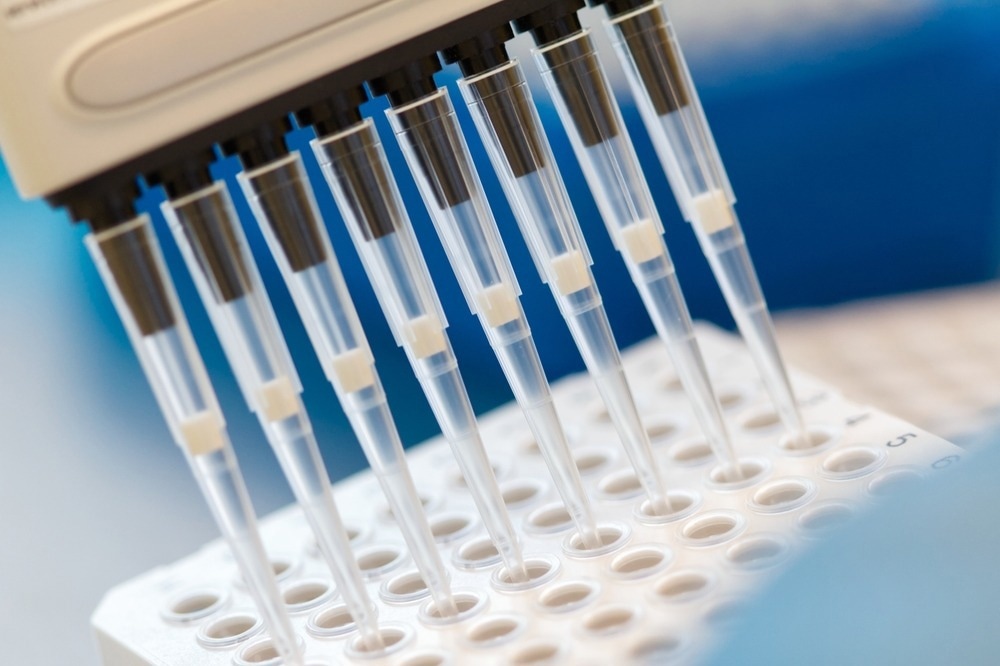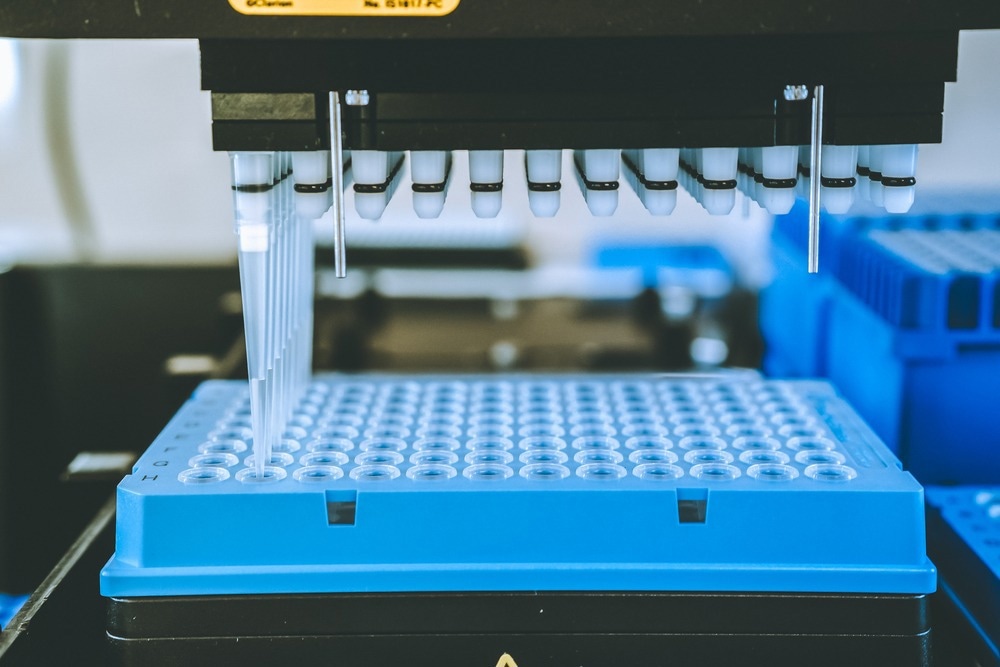A pipette is one of the most common equipment pieces used in laboratories. They are employed in the process known as pipetting, which involves measuring and moving liquids. Using the equipment, the user can set the desired volume and, with the aid of a plunger, aspirate a volume of the liquid through the pipette tip, which retains the amount of liquid desired.
To dispense the liquid, the user presses the plunger, which pushes the liquid out of the pipette tip. The pipette tips vary in capacity according to the volume to be measured.

Image Credit: nevio/Shutterstock.com
Uses of Pipettes in Typical Experimental Workflows
Users typically use pipettes for aliquoting, mixing, and serial dilution of liquids in experiments. Pipettes are very useful because they ensure the safety of the user in situations where the liquids could be unsafe such as with strong acids.
Pipettes enable the user to carry out experiments in a systematic way accurately keeping track of the volumes of liquids used.
Pipetting is typically the initial step in an experimental procedure, and as a result, it significantly affects all of the experiment's outcomes. Inconsistent volume measurements, sample contamination, and even damage can result from poor pipetting techniques. This could lead to inadequate data, poor reproducibility, or serious health problems for the technician.
Challenges Associated with Manual Pipetting
Despite the benefits of pipettes that help improve the quality of experiments, some challenges are associated with their use. Pipetting on its own often takes about up to 80% of a typical workday for some laboratory technicians. Also, pipetting volumes can become inconsistent when the users get tired, leading to systematic errors.
There is still some level of risk associated with using pipettes, especially when working with dangerous fluids when the equipment is not handled with the proper technique.
Benefits of Using Robots in the Lab
To address the challenges with manual pipetting, labs are seeking alternative automated options for their liquid handling processes.
Robots are convenient automation options that have been shown to address challenges from manual pipetting. If a task is repetitive, robots can keep working at the same pace and consistently without the need for breaks or being influenced by fatigue or boredom, increasing productivity.
Other advantages include reducing error, safer working conditions, customization, saves both cost and space in the laboratory.
What is Automated Pipetting and How Does it Work?
Automated pipetting systems fall under the category of liquid handling instruments, which typically perform similar functions as manual pipettes. Automated liquid handling systems are intended to greatly improve workflow accuracy for various liquid types and volume ranges while speeding up the pipetting and dispensing process compared to human pipetting.
An automated pipetting device works similarly to a manual pipette in that it draws liquid from a source by creating suction or aspiration and dispenses it over the target container. The system's pipetting head is what makes this possible.
However, automated methods are not without their flaws. These techniques frequently have complicated learning curves. Applications are still somewhat susceptible to human mistakes, and apparatus can be challenging to modify between runs.
Commercial Examples of Automated Pipetting Solutions
Automated pipetting solutions often vary in their apparatus and level of automation. Some are fully automated, while some can be semi-automated.
Automated liquid handlers can provide the high reproducibility required for microplate-based applications, such as the Precision™ Microplate Pipetting System from BioTek Instruments. Since the procedure is automated, the technician is free to focus on other laboratory activities or the analysis and interpretation of results.
Automated liquid handling systems also minimize repetitive strain injuries, which increase insurance costs and result in missed productivity.
The Corning® Lambda™ EliteMax Semi-automated Benchtop Pipettor from Corning is a space-constrained lab bench's semi-automated, inexpensive, and simple-to-use liquid handler with the strength and capacity to execute high content screenings for huge volumes of tests. This device's operation can be controlled manually or through a user interface with a large screen that is simple to use for customers.
Consumables can be set in a landscape or portrait orientation, and the unit already has a single-channel and 12-channel head fitted. For the system to record user preferences, protocols, and methods, several user accounts can be created. It transfers liquids and substances between microplates with accuracy and precision.

Image Credit: Elpisterra/Shutterstock.com
Future Outlook of Robots and Automated Pipetting Units in the Lab
Data quality remains one of the most compelling reasons for labs to employ automation. According to a recent survey, up to 78% of participants indicated that improving the accuracy, standardization, and reproducibility of their results remains a major challenge.
The challenges encountered with manual pipetting constitute automation favor. As such, there exists a huge demand and market for automated liquid handling solutions. From 2022 to 2028, the market for automated pipetting systems is projected to expand significantly, growing at a 5.5% CAGR.
The advantages and features of robots and automated pipetting systems, such as their safety, high accuracy, productivity, and user-friendly design, are the primary forces behind their market expansion.
Leading companies like Eppendorf continue to invest a lot of money in upgrading automation so they can offer higher-value products. During the recent COVID-19 epidemic, automated items were in great demand, which also fuelled expansion in these industries.
As technology advances, it is anticipated that the adoption of robots and automated devices in the lab will follow as labs look for solutions to the persisting problems encountered with hand pipetting.
References and Further Reading
Eppendorf (2016) Impact of Pipetting Techniques on Precision and Accuracy - Eppendorf Handling Solutions [Online]. Eppendorf. Available at: https://handling-solutions.eppendorf.com/liquid-handling/pipetting-facts/pipette-calibration/detailview/news/impact-of-pipetting-techniques-on-precision-and-accuracy/
Moore, S. (2020) Benefits of Laboratory Robotics [Online]. News-Medical.net. Available at: https://www.azolifesciences.com/article/Benefits-of-Laboratory-Robotics.aspx
Omr global (2019) Automated Pipetting System Market Size & Growth Report, Forecast to 2028 [Online]. Orion Market Research. Available at: https://www.omrglobal.com/industry-reports/automated-pipetting-system-market
O'Driscoll, A. (2021) Manual or Automated? Choosing the Best Method of Pipetting [WWW Document]. Lab Manager. Available at: https://www.labmanager.com/product-focus/manual-or-automated-choosing-the-best-method-of-pipetting-27147
Sptlabtech (2022a) Automated Pipetting Systems - Comparison Guide | SPT Labtech [Online]. sptlabtech. Available at: https://www.sptlabtech.com/automated-pipetting-the-complete-guide
Sptlabtech (2022b) Industry Report: The State of Automated Pipetting 2022 [WWW Document]. sptlabtech. Available at: https://www.sptlabtech.com/blog/the-state-of-automated-pipetting-2022
Disclaimer: The views expressed here are those of the author expressed in their private capacity and do not necessarily represent the views of AZoM.com Limited T/A AZoNetwork the owner and operator of this website. This disclaimer forms part of the Terms and conditions of use of this website.